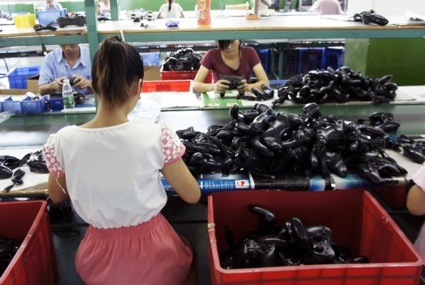 Lisa Ma is interested in the fringes of society. From the ladies who are mad about cats to the communities campaigning to stop the extension of Heathrow Airport. Lisa is a designer and her role is to create platforms of engagement with these groups which are otherwise ignored by society.
Lisa Ma is interested in the fringes of society. From the ladies who are mad about cats to the communities campaigning to stop the extension of Heathrow Airport. Lisa is a designer and her role is to create platforms of engagement with these groups which are otherwise ignored by society.
One of her latest projects drove her to a joystick factory located in one of the suburbs of Shenzhen. She spent several weeks with the factory workers, sleeping in dorms, sharing their meals in the canteen, making friends.
Because most of these young factory workers come from a farming background and because joysticks might very well become obsolete soon, she proposed to the factory owners that they’d allow the joystick makers to work part-time in a nearby farm. She called the experiment Farmification – using farming to keep the factory community together when work dwindles.
Almost everything about the project intrigued me. So i asked the designer to give us more details about Farmification:
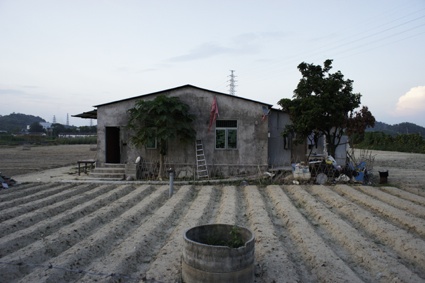 Hi LIsa! In your video you say that there are more than 230 million Chinese migrant workers? Why do you think we know so little about them? Is it because we prefer not to know about who they are and how they live? Or is it because it is difficult for an outsider to gain access to these factories?
Hi LIsa! In your video you say that there are more than 230 million Chinese migrant workers? Why do you think we know so little about them? Is it because we prefer not to know about who they are and how they live? Or is it because it is difficult for an outsider to gain access to these factories?
We tend to be conscious of Chinese factory workers as a working mass. For example ABC’s “Monday morning, at the Foxconn’s recruiting centre over 3000 people have been lined up, desperate to work for Apple’s biggest supplier”, we hear about the impressive scale rather than relate to the workers as humans. When journalists write about factory salaries they are describing these workers in terms of economic values. Focusing on sensationalist extremes makes the workers difficult for us to relate to on a human scale and distances them, whereas I look into the workers’ daily lives and highlight their mundane events to make them more emotionally accessible for the viewers.
The manufacturing of our products is really a very secretive process. We are starting to grow a consciousness about material and ecological costs in the items that we use but there’s a huge part of how they are made that is still in the shade. The recent Foxconn stories have brought more attention to this but there are other examples of how the story of manufacturing affects consumption:
-In 2011, a luxury Italian furniture company called Davinci caused outrage in Chinese customers when it was exposed that their ‘imported’ products was in fact made in China. “By spending a day in the bonded zone, the furniture had changed from being classed as domestically produced” to being labelled as Italian-made.” Robert Olsen, Forbes, 1/05/2012.
-The value of a workforce demonstrates itself (sadly) in any touristic craft store, where there’s a supposed craftsman making spoons out of horn or glass-beaded bracelets for sale. The narrative process of the products becomes the main selling point.
-The village of Dafen specialises in making fake paintings. The process of faking a famous painting has actually become an tourist attraction. The point is that vendors can position their value in the craft process, even if it’s faking a famous painting. (Ironically, due to Dafen’s success, now other villages reproduce their own ‘fake Dafen fakes’.)
One possibility is that products might have a “Responsible Life-Work Balance” standard, similar to the “Free From Animal Testing” labels that we’ve become accustomed to as consumers. However, this is a very paternalist view of our connection with the manufacturing process. The goal of my research isn’t just to dictate what “good practice” should be. The stories I’ve been revealing hope to show the different threads of problems rather than a single answer that fits all. Through “Farmification”, I’m giving a design suggestion that would invite more potential alternatives by making the issue more approachable.
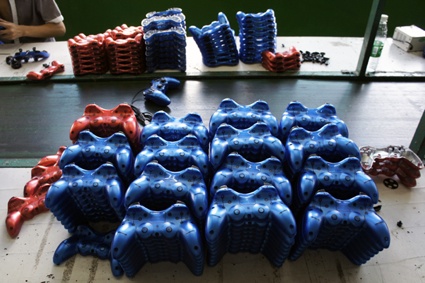
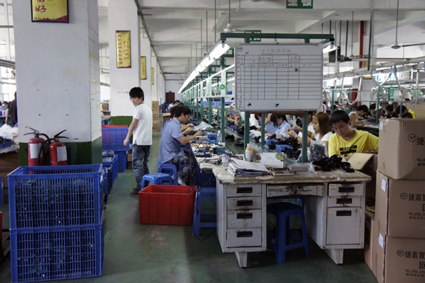 How did you manage to get access to a joystick factory in China? Was it a long and painful process or did it require little more than an email?
How did you manage to get access to a joystick factory in China? Was it a long and painful process or did it require little more than an email?
The best explanation is that “contacts of contacts” offered to me to stay in either a handbag factory or a joystick factory. I chose the joystick, largely because it was interesting as a technology on its way out.
It was a no frills package. I was literally sleeping in the dorms and eating with the workers day after day. At one point I was about to be covered in heat rashes and the factory owner, in exchange for some of the photographs, let me have his spare apartment. There were no glass in the windows and the air conditioning leaked over the bed. For a while I was sleeping with a bowl in my bed. On my third week I managed to ‘bribe’ a production manager, over a meal of duck congee, to link his broadband from the second floor window across to my window on the fifth floor, for 50rmb (£5). That was probably the best investment I’ve made.
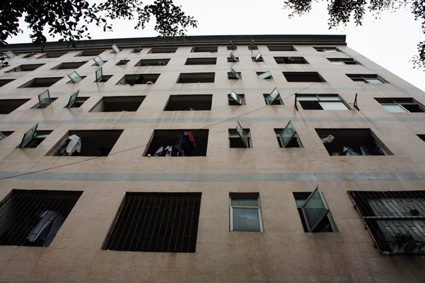 Ethernet cable
Ethernet cable
I thought the place was pretty secure, with guard dogs everywhere, but once someone tried to force open my lock in the middle of the night. They took so long that I managed to boil a kettle of water to defend myself. It was like the Three Little Pigs. Luckily for both of us, the door held.
Sometimes I was really questioning if I was doing the right thing but it was worth it. I stayed for about 6 weeks there and after half a year, returned to them with my proposal.
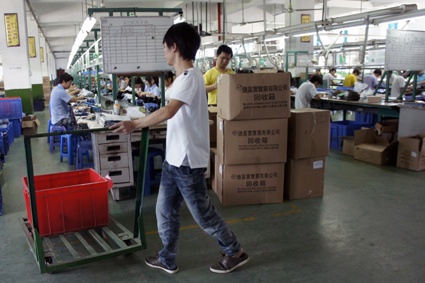
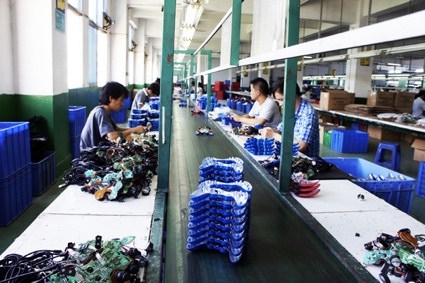
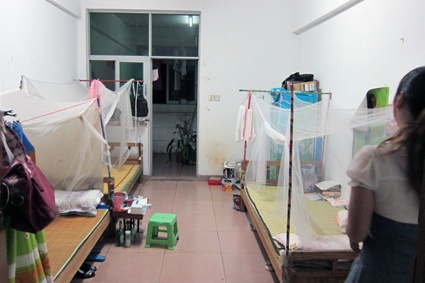 Girl Dorm
Girl Dorm
What makes a joystick factory a fringe? Because surely 230 million people cannot be regarded as fringe?
Factory workers are fringe in terms of our awareness and industrial concern, not in terms of scale. There is in fact a huge amount of people in the peripherals of our vision. Joystick factory workers, specifically, are at the fringe of the innovation cycle. They are at the brink of being left out from demand for the products that they manufacture. They are an emerging group of people designed out by technology.
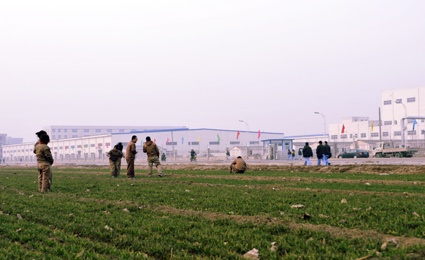
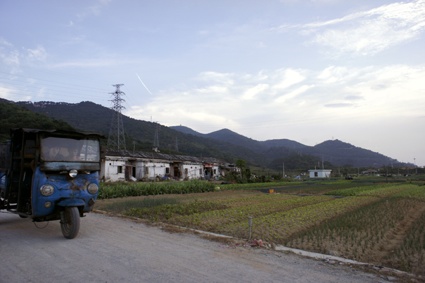 If I understood correctly, you proposed to the factory owners that workers would work part time at the farm. But what benefit (financial and non financial) is there for the owners of the factory to see their employees desert the building to work in the field?
If I understood correctly, you proposed to the factory owners that workers would work part time at the farm. But what benefit (financial and non financial) is there for the owners of the factory to see their employees desert the building to work in the field?
I’m proposing to encourage debate for all stakeholders, workers, owners, farmers, governments and internationally consumers. Farmification benefits the owners because it increases longevity in their businesses. Farmification would help the community that the owners invested time to build to remain alive through the cycles of a product. For the workers, Farmification stabilises their community as well as deals with their issue of disconnection with their origins. Farming is less alienating than manufacturing because the producers can be directly consumed locally, whereas in factory manufacturing the producers probably can never afford their own product. In addition, factories use shift-work so that the buildings are hardly ever left empty.
In Europe, there is a similar debate of “Farmification” for people to sustain themselves with direct food security. The allotments in the United Kingdom sustained the population against social unrest in the economic depression of in 1930s. Currently there are innovative farming movements with people such as Incredible Edible working to revive farming during the recession and making an impact on British policy-makers.
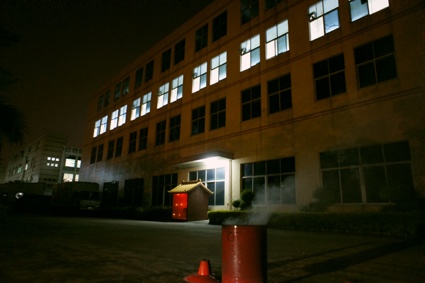 Mini shrine where workers burn fake money to their ancestors
Mini shrine where workers burn fake money to their ancestors
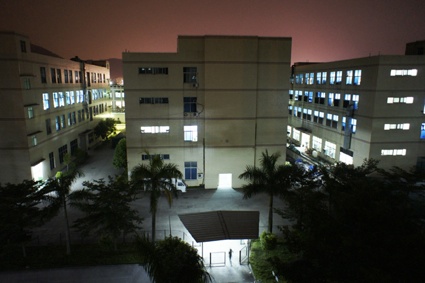 Factory dormitory units
Factory dormitory units
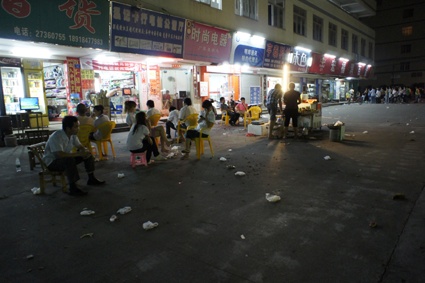 Watching tv in the street
Watching tv in the street
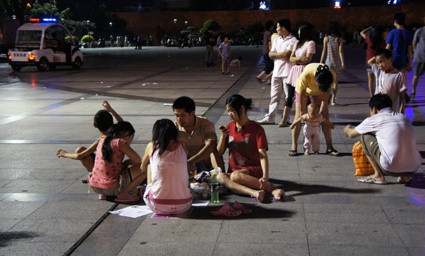 Family picnic
Family picnic
What is going on at the farm nowadays? Are people still working there?
The factory is sadly downsizing and the farm is a strawberry field right now. I’m not sure if anyone will appreciate the irony of Strawberry Fields Forever.
 Image: 鸡爪图片 noiawin
Image: 鸡爪图片 noiawin
Did you find the answer to that question you’re asking in the video “who’s making all the food now”?
China’s importing huge amounts of food internationally. For example, the chicken feet, which are Chinese delicatessens are being imported out of American chicken factories as waste products. This is a nice story of recycling but depending so heavily on importation is not sustainable for the largest population in the world. China’s importing grain in record numbers. There is a 500% increase since last year and it’s having a huge impact on the price of food for the global community.
 And finally can you tell us a few words about the other fringes you’ve been exploring since the Farmification project or the fringes that you are planning to explore in the coming months?
And finally can you tell us a few words about the other fringes you’ve been exploring since the Farmification project or the fringes that you are planning to explore in the coming months?
Building up from a previous project, Heathrow Heritage, about a local airport community and it’s activists, I explored similar possibilities in the airport of Shenzhen. A large proportion of Chinese airspace is militarized and passengers complain of the long delays, often abusing airport staff without giving the problem any further thought. I’m taking stranded passengers out of Shenzhen airport and into the snack streets of the slums surrounding the airport, where the staff live.
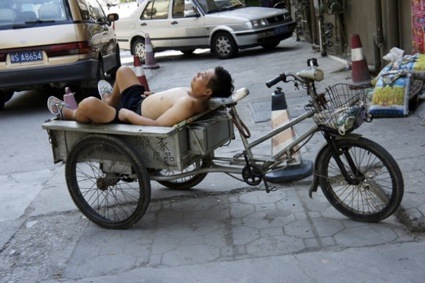 Lunch break around Shenzhen airport
Lunch break around Shenzhen airport
I’m also starting a collaboration with mindfulness coaches Headspace to break the stereotypes of the meditation community.
Finally, I’m finishing off workshops I hosted on The Future of Sex Education in a Beijing Love Hotel. This project investigates what a sexually active generation, that’s never had its own sex education, demand of the future generation. As one of the participants in the workshop puts it: “girls learn from their boyfriends and the boys learn from porn”. The collaborators and I had to get through every loophole possible, for example, the anti-nudity technology was so crude that Garfield the cartoon cat was banned because of its tanned body. How do these people evolve their own fantasies when their first points of reference are from Western pornography downloaded from illegal cafes?
Thanks Lisa!
Previously: Heathrow Heritage.
Related: Err (or the creativity of the factory worker), a conversation with Jeremy Hutchison.
